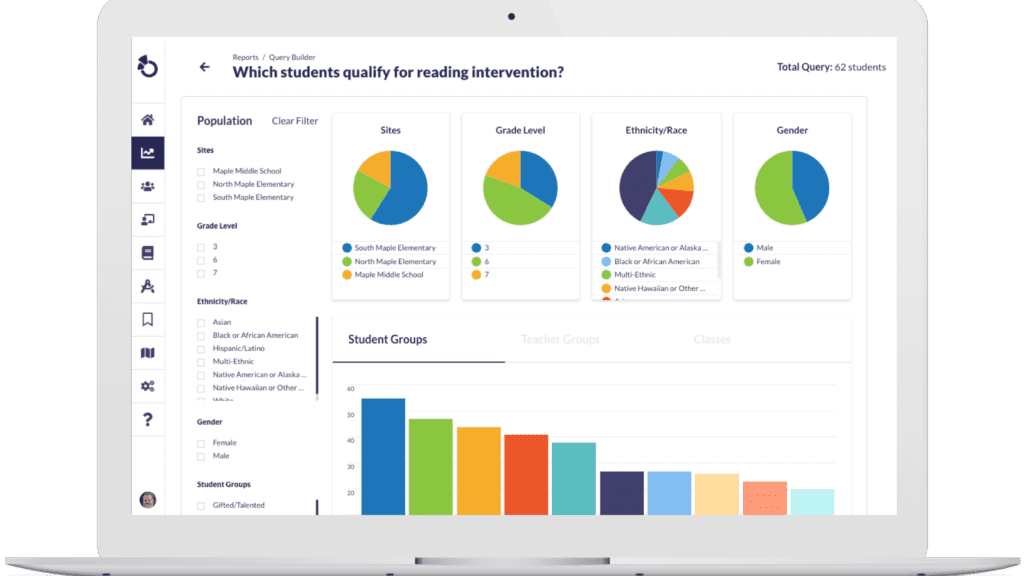MTSS for Reading: Building a Prevention-First Literacy System (2026)
By: Otus Team
For many schools, literacy initiatives feel like deja vu. State mandates emphasize the science of reading, new screeners roll out each year, and teachers adjust their day-to-day instruction to build stronger reading foundations. Yet despite these efforts, entirely too many students still struggle to read proficiently by third grade.
The problem isn’t a lack of effort. The problem is timing.
Support often arrives only after students fall behind. That’s why schools across the country are turning to a prevention-first approach, applying the Multi-Tiered System of Supports (MTSS) to literacy.
When reading instruction and MTSS work together, every student gains a clearer path toward literacy success.
Prevention, not reaction: The heart of literacy MTSS
 A prevention-first approach to reading starts with the belief that every student deserves strong instruction from the start, not just intervention after they struggle.
A prevention-first approach to reading starts with the belief that every student deserves strong instruction from the start, not just intervention after they struggle.
MTSS organizes reading support into tiers that respond to students’ needs as they emerge. Universal screeners, progress monitoring, and collaboration between teachers and specialists keep instruction responsive and proactive.
In other words, the goal isn’t to catch up struggling readers. It’s to make sure fewer students ever fall behind.
Tier 1: Universal Reading Instruction
Tier 1 is the foundation of student success, and that applies to literacy, too. It’s the high-quality, standards-aligned instruction that every student receives every day.
What it looks like in practice:
- Direct, systematic instruction in phonemic awareness, phonics, vocabulary, fluency, and comprehension.
- Whole-class and small-group reading lessons built on clear learning goals
- Universal screeners three times per year to check progress
- Collaboration through PLCs to adjust instruction based on data
When Tier 1 is strong, most students thrive. But when data shows a need for more support, MTSS helps educators act quickly.
Tier 2: Targeted reading interventions
Tier 2 provides focused, short-term support for students who need additional help beyond the core classroom instruction.
What it looks like in practice:
- Small-group instruction focused on phonics, fluency, or comprehension
- Guided reading groups during an intervention block
- Weekly check-ins to monitor progress and adjust goals
- Collaboration between classroom teachers and reading specialists
Tier 2 support is designed to close gaps quickly and build confidence before reading difficulties intensify.
Tier 3: Intensive, individualized literacy support
Tier 3 offers the most personalized support for students with ongoing reading challenges.
What it looks like in practice:
- One-on-one instruction with a literacy specialist
- Diagnostic assessments that pinpoint specific skill deficits
- Frequent progress monitoring and goal-setting
- Individualized intervention plans created with family input
Tier 3 is intensive by design but still rooted in the same prevention-first philosophy: data-driven, collaborative, and flexible.
Where the science of reading fits into MTSS
 The science of reading is most closely tied to Tier 1, the foundation of daily literacy instruction, but its principles strengthen every tier of an MTSS framework. It offers a clear roadmap for how students learn to read, while MTSS ensures those practices are applied consistently and responsively across classrooms.
The science of reading is most closely tied to Tier 1, the foundation of daily literacy instruction, but its principles strengthen every tier of an MTSS framework. It offers a clear roadmap for how students learn to read, while MTSS ensures those practices are applied consistently and responsively across classrooms.
Schools that align the science of reading with MTSS are more likely to see consistent results. Instructional methods stay rooted in evidence, and interventions build on the same practices used in daily instruction, just with greater focus and intensity. This consistency helps students experience a seamless path toward reading proficiency, no matter which tier of support they’re in.
In other words, the science of reading explains how students read. MTSS ensures every student has the opportunity to do it well.
The role of data in a reading MTSS
Data is what connects each tier. From universal screeners to progress monitoring tools, every piece of reading data tells part of a story about student growth.
When that data is unified, educators can:
- Identify early signs of reading difficulty
- Track progress across tiers and over time
- Coordinate supports between teachers, specialists, and administrators
Without shared data, reading interventions can feel disconnected. With it, schools create a cohesive, responsive system that meets students where they are.
When literacy data speaks a common language, every educator becomes part of the reading success story.
4 ways Otus makes reading MTSS happen
Talking about MTSS for literacy is one thing, but turning it into an effective, daily practice takes the right tools and visibility. That’s where Otus comes in.
In Otus, educators can:
- Bring together data from reading screeners, classroom assessments, and progress monitoring in one place
- Use AI-powered insights to identify trends and early warning signs
- Track reading interventions across all MTSS tiers
- Collaborate with teams to align supports with district literacy goals and state frameworks
Whether navigating the Minnesota READ Act, the Virginia Literacy Act, or local district literacy plans, Otus helps educators design a system that puts prevention first.
Turning prevention into progress
Identifying which learners need help is no doubt a key to reading success, but MTSS is about creating a system that ensures every student receives evidence-based instruction from the start.
When prevention leads the way, intervention becomes part of a continuous cycle of growth, and every student has the opportunity to thrive as a reader.
Related Resources
Request a demo!
See exactly how Otus can help your school accelerate student growth and improve student outcomes – all while saving educators time.





